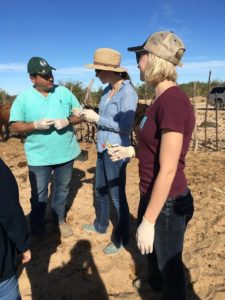
Name: Jose Alberto Erales Villamil
Title/role at CSU: DVM, MSc, PhD
When did you visit the CSU Todos Santos Center?
I have visited the Todos Santos Center three times now. My first visit was in November, 2016, to attend the first One Health for the Americas meeting. We had a two-day meeting where people from Canada, Mexico, the U.S., England, Brazil, Guatemala, and Chile participated, presenting their work, interests, and ongoing projects related to health under the One Health approach. My second visit was in May 2017, to participate in the “Día Del Ganadero” conference, where researchers from Mexico and the U.S. presented different strategies on nutrition, reproduction, health, and husbandry management to livestock farmers in order to help improve their farms. My third visit was in January 2018, and I participated as a mentor for the first DVM student group of the 2018 spring semester under the coordination of Dr. Danielle Straatmann.
What did you work on during your trips to Todos Santos?
My work is related to livestock medicine and production, and most recently, I was invited by Dr. Straatmann to participate in this program, particularly regarding livestock farmers. I spent 10 days working with a fantastic group of students. We visited livestock farms and took samples from a few animals; we also visited a community elementary and middle boarding school, where CSU DVM students presented in Spanish about the dangers of rabies as a disease that can be shared by humans and animals. The DVM students also had the opportunity to practice and improve their surgical ability by spaying and neutering dogs and cats, in collaboration with local campaigns.
What did you find most rewarding about your experience in Todos Santos?
The gratitude from the people. When their animals are recovering from surgery or after visiting a farm and sharing time with them, the gratitude from the people is evident. The engagement that people in this program have with the Todos Santos community is evident, and for me, that is the most rewarding of all the great experiences I have enjoyed at the Todos Santos Center.
What is your favorite thing about the Todos Santos community?
The people. They are friendly, hard-working, and open to sharing their thoughts or needs. I also enjoyed watching whales jump and breach in front of the setting sun… unforgettable!
Is there anything else you want people to know about CSU’s involvement in Todos Santos?
I think the Todos Santos Center provides a great opportunity for DVM students and students pursuing other careers at CSU to get involved in the real, everyday life of a small community. Participation in programs like this can have a profound impact on one’s professional life and provide the tools and sensitivity to address issues like pet animal overpopulation or livestock animal basic needs. I strongly recommend students and professors get involved with the Todos Santos Center!
About the CSU Todos Santos Center
The Colorado State University Todos Santos Center is the University’s first international location and is core to CSU’s mission of teaching, research, service, and outreach.
The Center provides opportunities for CSU students and Baja California Sur residents to collaborate with local partners and businesses to identify needs, conduct research, and produce impactful outcomes.
CSU’s vision in Todos Santos is to cultivate generations of global citizens and to be a part of creating thriving communities through collaboration, experience and exchange of knowledge in areas such as agriculture, infectious disease, elementary education, environmental and social sustainability, wildlife ecology, veterinary medicine, and public health.